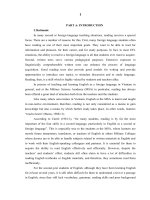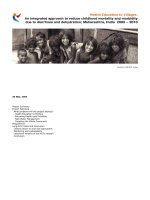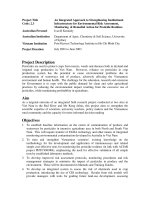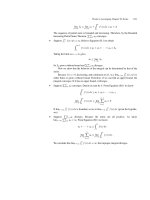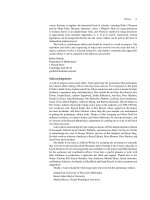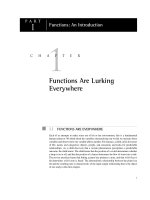An integrated approach to teaching listening and note taking skills to first year english majors at binh duong teachers training college
Bạn đang xem bản rút gọn của tài liệu. Xem và tải ngay bản đầy đủ của tài liệu tại đây (4.42 MB, 90 trang )
VIETNAM NATIONAL UNIVERSITY – HCM CITY
UNIVERSITY OF SOCIAL SCIENCES AND HUMANITIES
AN INTEGRATED APPROACH TO
TEACHING LISTENING
AND NOTE-TAKING SKILLS
TO FIRST-YEAR ENGLISH MAJORS AT BINH DUONG
TEACHERS’ TRAINING COLLEGE
A THESIS SUBMITTED IN PARTIAL FULFILLMENT
OF THE REQUIREMENTS FOR THE DEGREE OF
MASTER OF TESOL
SUBMITTED BY: NGUYEN NAM PHUONNG
SUPERVISOR: SIDSEL MILLERSTROM, Ph. D.
HO CHI MINH CITY: JANUARY 2010
CERTIFICATE OF ORIGINAL
I certificate my authorship of the thesis submitted today entitled:
AN INTEGRATED APPROACH TO TEACHING LISTENING AND NOTETAKING SKILLS TO FIRST-YEAR ENGLISH MAJORS AT BINH DUONG
TEACHERS’ TRAINING COLLEGE
in terms of the statement of Requirements for Thesis in Master’s Programs issued
by the Higher Degree Committee. This thesis has not been submitted for the award
of any degree or diploma in any other institution.
Ho Chi Minh City, January 2010
Nguyen Nam Phuong
i
RETENTION AND USE OF THESES
I hereby state that I, NGUYEN NAM PHƯƠNG, being a candidate for the
degree of Master of Arts (TESOL) accepted the requirements of the University
relating to the retention and use of Master’s Theses deposited in the Library.
In terms of these conditions, I agree that the original of my thesis
deposited in the Library should be accessible for purposes of study and research,
in accordance with the normal conditions established by the Library for the care,
loan or reproduction of theses.
Ho Chi Minh City, January 2010
Nguyen Nam Phuong
ii
ACKNOWLEDGEMENTS
First of all, I would like to express my deep gratefulness to my thesis
supervisor, Dr. Sidsel Millerstrom together with Dr. Nguyen Hoang Tuan who
willingly gave me valuable evaluations and comments on my project any time I
needed it. I am thankful for her support in my preparation and completion of this
thesis.
I would also like to thank the organizers of the Post Graduate Study Program
in TESOL, Mr. Le Huu Phuoc, Head of the Department of Post Graduate, and Ms
Nguyen Thi Kieu Thu, Head of the Department of English Linguistics and
Literature of HCMC University of Social Sciences and Humanities.
Last, but not least, I wish to give my profound gratitude to my colleagues of
the Department of Foreign Languages, Binh Duong Teacher Training College
where I work and as well as the first-year English-majored students at the college
for their kind help and enthusiastic support that have facilitated me to conduct the
survey and complete the thesis.
iii
ABSTRACT
The learners of English referred to in this project are defined as the first-year
English-majored students at Binh Duong Provincial Teachers’ Training College
who have taken up the English language as their future professions. Therefore they
are expected to master all the language knowledge and train to enhance all the
language skills. On developing their listening and note-taking skills, they have to
cope with numerous problems affecting their abilities of understanding of spoken
English and of note-taking in listening class as well as in other English subjects in
their college syllabus.
To identify the students’ reality of learning the listening and note-taking
subjects, a survey was conducted to discover: (1) their inhibition in listening and
note-taking activities in listening classes and college lectures requiring their taking
notes for later tests or exams, (2) listening tasks, activities and teaching techniques
selected and applied by their teachers.
The implications of the findings in chapter four prove that most of the
students (1) are afraid of the listening subject and get very little acquisition in it, (2)
are inhibited by several factors in listening and note-taking activities, and (3) find
that listening tasks and activities and teachers’ teaching techniques are not
consistent, effective or encouraging. Eventually, the findings of the learners’ reality
in listening and note-taking greatly hinder their abilities of communication in
spoken English as well as in learning other subjects needing their taking notes for
their tests or exams.
Finally, some effective teaching strategies and activities integrated with note
taking will be applied to improve their quality of understanding oral English in
listening class and college lectures.
iv
TABLE OF CONTENTS
CERTIFICATE OF ORIGINAL ............................................................................... i
RETENTION AND USE OF THESES ....................................................................ii
ACKNOWLEDGEMENTS ....................................................................................iii
ABSTRACT ........................................................................................................... iv
TABLE OF CONTENTS ....................................................................................... iv
LIST OF FIGURES ..........................................................................................vviiiii
LIST OF TABLES ................................................................................................. ix
LIST OF ABBREVIATIONS .................................................................................. x
Chapter 1 INTRODUCTION ....................................................................... 1
1.1 BACKGROUND TO THE STUDY ..................................................................1
1.2 AIMS OF THE STUDY ................................................................................... 1
1.3 RESEARCH QUESTION ..................................................................................2
1.4 TERMINOLOGY ..............................................................................................2
1.5 SIGNIFICANCE OF THE STUDY ...................................................................3
1.6 OVERVIEW OF THE STUDY .........................................................................4
Chapter 2 LITERATURE REVIEW .........................................................5
2.1 CONCEPTS AND CHARACTERISTICS OF THE LISTENING SKILL .................5
2.1.1 Definitions of listening comprehension....................................................5
2.1.2 Purposes of listening.................................................................................7
2.1.3 Stages in listening ....................................................................................8
2.1.4 Listening techniques...............................................................................10
2.2 CONCEPTS AND CHARACTERISTICS OF NOTE-TAKING .................... 11
2.2.1 Definitions of note-taking ........................................................................ 11
2.2.2 Purposes of note-taking in listening comprehension ................................ 12
2.2.2 Note-taking techniques .......................................................................... 13
2.3 TEACHING LISTENING INTEGRATED WITH TAKING NOTES ............ 17
2.3.1 Aspects of integrating listening and note-taking ....................................17
v
2.3.2 Getting ready to listen to a lecture and make notes ....................................18
2.3.3 Listening and note-taking strategies ...........................................................19
2.4 SUMMARY ...................................................................................................20
Chapter 3 METHODOLOGY....................................................................22
3.1 Research design ............................................................................................... 22
3.2 Subjects ........................................................................................................... 23
3.3 Questionnaire ..................................................................................................23
3.3.1 Questionnaire for students......................................................................... 23
3.3.2 Questionnaire for teachers ........................................................................ 23
3.4 Instruments and Data Collection Procedures .................................................... 23
3.5 SUMMARY ....................................................................................................25
Chapter 4 DATA ANALYSIS AND DISCUSSIONS .......................... 26
4.1 FINDINGS OF QUESTIONNAIRE FOR STUDENTS ..................................26
4.1.1 Students’ reality of practicing the listening skill ....................................26
4.1.2 Students’ attitudes towards listening classes at high school .................. 32
4.1.3 Students’ participation in listening activities .........................................35
4.1.4 Students’ understanding of note taking and note-taking techniques in
listening class at high school ...........................................................................40
4.2 FINDINGS OF QUESTIONAIRE FOR TEACHERS ....................................48
4.2.1 Teachers’ assessments on the listening subject and the act of teaching
listening to the freshmen majoring in English ................................................ 48
4.2.2 Teachers’ assessments on Pre-listening stage .......................................50
4.2.3 Teachers’ selections of listening activities and tasks.............................51
4.2.4 Teachers’ degrees of preparation to involve students into listening act in
class .................................................................................................................52
vi
4.2.5 Teachers’ degree of teaching students how to take notes in listening
class .................................................................................................................54
4.3 SUMMARY ....................................................................................................55
Chapter 5 IMPLICATIONS AND RECOMMENDATIONS ............56
5.1 Implications and Recommendations.................................................................56
5.2 Suggested classroom techniques in teaching listening integrated with note
taking techniques..................................................................................................57
5.2.1 Introduction to the topic and/or situation of the listening texts and/or
conversations in the pre-listening stage .......................................................... 58
5.2.2 Giving listening tasks to students before the while-listening stage .......61
5.2.3 Identifying and making notes of information or ideas related to the
while-listening tasks........................................................................................ 62
5.2.4 Guessing meanings, contents and/or ideas from identified and
understandable words and expressions ...........................................................63
5.2.5 Taking notes on statistics mentioned in listening texts ..........................64
5.3 LIMITATION .................................................................................................66
5.4 CONCLUSION ............................................................................................... 67
BIBLIOGRAPHY ......................................................................................................... 69
APPENDICES
APPENDIX A
QUESTIONNAIRE FOR STUDENTS
71
APPENDIX B
QUESTIONNAIRE FOR TEACHERS
74
APPENDIX C
SAMPLE LESSON PLAN
vii
77
LIST OF FIGURES
Chapter 4
Figure 1: Teachers’ degrees of paying attention to students’ needs and interests in
learning the listening subject
Figure 2: Teachers’ degrees of application of Listening Activities and Tasks
Figure 3: Teachers’ degrees of asking and instructing students to take notes in
listening class at college
Figure 4: Teachers’ degrees of requiring and instructing students to take notes in
listening class
Chapter 5
Figure 5: A printed photograph of the conversation about checking into a hotel
viii
LIST OF TABLES
Table 1: Students’ degrees of practicing listening to spoken English
Table 2: Students’ Assessments on Listening subject
Table 3: The basic listening activities given to students in listening classes at high
school
Table 4: Students’ acquisition of study skill and note taking at high school
ix
LIST OF ABBREVIATIONS
L1
First Language / Native language
L2
Second Language / Foreign Language
SLA
Second Language Acquisition
EFL
English as a Foreign Language
ESOL
English for Speakers of Other Languages
x
Introduction
Chapter 1
INTRODUCTION
1.1 BACKGROUND TO THE STUDY
Studies of Langan [2002: 43] have showed that within two weeks learners
probably will forget 80percent or more of what they have heard, and in four weeks
they are lucky if 5percent remains. To guard against the relentlessness of forgetting,
students must take notes of the information presented in class and study the notes so
that they understand and remember the ideas. However, the problem is that most of
the first year English-majored students at Binh Duong Teachers’ Training College
do not know how to take notes when they listen to listening texts, their teachers or
their classmates. And so they write down or copy down every word they have
listened to so that they don’t have enough time to do it and typically record
incomplete notes, usually 20-40 percent of the important lecture ideas. They don’t
know how to use abbreviations along with symbols to keep up with the professor’s
lectures. The more complete their notes are when they review them, the more likely
they are to master the material.
Being a teacher at Binh Duong Provincial Teachers’ Training College for a
number of years now, we have always been concerned in improving our Englishmajored students’ speaking and listening ability. And since I was placed in charge
of the subject of note-taking some years ago, I have found it essential to improve
the students’ listening and note-taking skills effectively, particularly the first-year
English-majored students.
1.2 AIMS OF THE STUDY
The study is aimed at investigating the reality of the first-year Englishmajored students’ learning listening comprehension at high schools (before they
entered college) as well as their reality and quality of their practicing and
developing their listening and note-taking of spoken English in the first year at Binh
1
Introduction
Duong Teachers’ Training College. Through those findings, the study suggests
some recommendations for improving students' motivation in listening and notetaking through an integrated approach.
1.3 RESEARCH QUESTION
In order to reach the aim of the study, the process of researching is guided by
the major question:
What effect does the integrated approach to teaching listening and notetaking have on learner’s attitude at Binh Duong Teachers’ Training College?
In order to clarify the matters related to this question and to support the
general purposes, the study also deals with some more sub-questions:
- What kinds of techniques and activities in listening and note taking were
learners exposed to at high school and at Binh Duong Teachers’ Training College?
1.4 TERMINOLOGY
1.4.1 Note-taking
Note-taking is one way to enhance listening, and using a systematic approach
to the taking and reviewing of your notes can add immeasurably to your
understanding and remembering the content of lectures. Effective listening and
note-taking require not only the ability to attend but other skills as well. At the same
time students have to write down what a lecturer has said, they must be able to
listen to what he or she is saying and to decide whether it is important enough to
write down as well. Also in a rapid lecture they must be able at times to store one or
more ideas in their memory so that they will be able to write them down next. If
they can “listen ahead” and process and remember what they hear at the same time
that they are writing rapidly, they will be listening efficiently. Their brain will be
able to work along with and ahead of their pen [Langan 2002:43].
2
Introduction
1.4.2 Integrated approach
An integrated approach to curriculum planning provides a way of exploring
concepts across subject boundaries. It enables students to make connections
between their own experiences and the ever-changing world outside.
An integrated approach begins with a big idea which is (1) a rich concept
with potential to develop students’ understandings of themselves and their world,
(2) relevant to students’ interests, (3) appropriate for the particular age and learning
environment and (4) a potential site for student investigation using a range of
processes.
Connecting ideas from several learning areas are identified, a context is
developed and a sequence of learning experiences for students is planned. For
example, “When I was One” is the title of a unit which might be appropriate for
students in prep/one classes. It provides opportunities to investigate personal
histories, using poetry as a context for the consideration of students’ likes and
dislikes, abilities and achievements. Students develop an awareness of the
similarities and differences between individuals.
1.5 SIGNIFICANCE OF THE STUDY
Listening and note-taking practice are an important part of interaction and
communication among people in general. A person good at listening comprehension
skill will be able to participate more effectively in communicative situations. It is
best-known among teachers of EFL and ESL that listening is one of the four basic
language skills in order of listening, speaking, reading and writing. Listening,
together with reading, is regarded as a receptive skill, and receptive skills give way
to productive skills. This brings us to the obligation of integrating language skills. It
is hoped that the study can be of some value in teaching and learning English in
Binh Duong province.
Within the contexts of at Binh Duong Teachers’ Training College and notetaking, this study used a survey to examine the current use of note-taking techniques
amongst first-year students. I examined the practices of general student note-taking
and adoption of and attitudes towards note-taking. The results of this study
3
Introduction
contribute to the understanding of the principles involved in supporting listening
comprehension especially of note-taking. It is hoped that the study can be of some
value in teaching and learning English in Binh Duong province. In the other hand,
this data provides guidelines that will hopefully enable the continued research of
interfaces to better support note-taking skill.
1.6 OVERVIEW OF THE STUDY
Chapter 1, the Introduction, explains the background to the research, the
statements of purpose, research questions, the significance of the research, the
assumptions, the limitations, the methodology, and the overview of the study.
In Chapter 2, the Literature Review presents the theoretical background to
the study, the role of listening in language teaching, categories of listening, notetaking techniques, and some aspects of integrating listening and note-taking in
teaching English.
Chapter 3, Methodology, describe the subjects, data collection instruments,
and the procedure of the study process.
Chapter 4, Data Analysis and Discussion, consists of the results of the
questionnaires, the results of the interviews, classroom observations, discussion of
the data, and the conclusion.
Chapter 5, Recommendations and Conclusion, suggests some integrated
techniques and activities to teach listening and note-taking skills, the limitations of
the study, suggestions for further research, and the conclusion of the research.
4
Literature review
Chapter 2
LITERATURE REVIEW
In this chapter, Literature Review, some concepts, characteristics and
purposes of listening and note-taking defined by previous methodologists will be
reviewed as the theoretical basis of the project. Besides, some basic techniques or
strategies, activities and tasks of listening and note taking will also be stated to help
solve the first-year English majors’ problems inhibiting their acquisition and
progress in listening class or any class lectures that require them to take a lot of
notes for their later revision for midterm tests, semester tests and/or final exams.
Ultimately, on the basis of these fundamental theories, some practical
solutions will be applied in the process of teaching the listening comprehension and
note-taking subjects to the first-year English-majored students at Binh Duong
Teachers’ Training College. The suggestions will be stated in chapter five, and they
will be used to develop the students’ competence of understanding spoken English
in listening class during their first-year curriculum at the college. Moreover, they
will simultaneously be used to enhance the students’ note-taking capacity in
listening class and/or in any classes of English specialized subjects in which
teachers deliver many lectures.
2.1 Concepts and characteristics of the listening in real life and in language
teaching and leaning
2.1.1 Definitions of listening comprehension.
First of all, some definitions of listening comprehension suggested by
previous methodologists will be reviewed hereafter as the basic understanding of
the listening act in real-life oral communication and interaction between or among
people. They are more important to be reviewed as the basic understanding of the
listening act in language learning and teaching in class of ESL and EFL as well.
According to the methodologist, Nunan [1999: 199], the listening skill in
language teaching and learning plays a much more important role than the speaking
one. It is generally known that human beings naturally listen to the language they
learn first of all and then they gradually get to understand it at a certain level before
5
Literature review
they are able to speak it as a child learns to speak its mother tongue. And when
learners of a second or a foreign language are able to speak it, they can initially utter
some simple words only. Later on they can just utter some simple and easy
sentences. In order to speak the language correctly and fluently, it takes them a
rather long time to practice speaking the language.
As mentioned above, the human natural listening act and the listening skill in
learning and teaching the English language in class is of great importance and is
always focused to be developed before other language skills as speaking, reading
and writing. Thus, Nunan [1997: 199] states, in his course book entitled as Second
Language Teaching and Learning, “listening is the Cinderella skill in second
language learning, and all too often, it has been overlooked by its elder sister –
speaking”.
It is apparent that understanding oral English is so indispensable in any
process of verbal communication and interaction between or among speakers.
Without one or both speakers’ comprehending the language, their conversation can
hardly or even impossibly be carried out. But in actual fact, learning a second or
foreign language as English, for many people, means being able to speak and write
that language rather than understand it in both spoken and written form. Hence,
listening and reading are therefore regarded as secondary skills. As a matter of fact,
people are not really aware of the importance of the listening act and the difficulty
in understanding spoken English in the process of verbal communication between or
among speakers in their community.
Doff [1988:198] refers to listening as a crucial factor of any human oral
communication as well as any classroom verbal interaction. In the aspect of
language teaching and learning, the listening act proves to be of greater importance.
Students must understand what is spoken to them if they want to have a successful
conversation, and it is impossible to develop students’ speaking skill if their
listening ability is not preferentially enhanced. Listening is therefore an effective
way of acquiring the language one studies such as grammar structures and
6
Literature review
vocabulary. The author states two types of real-life listening: casual listening and
focused listening. The first one occurs without the listener’s particular purpose and
concentration in mind. The later one is carried out on the purpose of finding out
specific information.
In his course book, The Language Teaching Matrix, Richards [1999: 50] also
advocates the same two types of processes involved in teaching and learning
listening comprehension as “bottom-up” and “top-down”. From Richards’s concept,
learners’ understanding a language begins with his or her acquisition of the
language as sounds, vocabulary, grammar and their analysis of such knowledge of
the language.
2.1.2 Purposes of Listening.
When people listen – whether they are listening to a lecture, a discussion, a
news broadcast, or a joke, or are engaging in a conversation – they are listening to a
stretch of discourse. In fact, listening is the most frequently used language skill in
human everyday life. Researchers (eg., Morley 1991; Rivers 1981; Weaver 1972)
estimate that people commonly listen to twice as much language as we speak, four
times as much as they read, and five times as much as they write. It is thus
remarkable that human beings spend much more time on listening than any other
activities of communication in their communities or by the mass media.
It is actually admitted that the act of human listening occurs everywhere.
Whenever two or more people meet and communicate, they talk and listen to one
another. They listen to various forms of spoken language all day everyday. For
instance, office workers listen almost everyday or even every hour on telephone or
cell phone; scientists or politicians listen to reports or discussions in workshops and
at conference; students listen to lectures at school. However, each person has his or
her completely different purpose of listening.
Thus in this part of the chapter, 2.1.2 some of human genuine purposes of
listening will preferentially be reviewed. And on the basis of the revision, the
7
Literature review
purposes of students’ listening in language classes will be determined so as to help
develop their listening skill more practically and effectively.
With reference to Hedge [2000: 235], in her course book Teaching and
Learning in Language Classroom, people have three main reasons for listening in
their daily life. The three purposes defined by Hedge, Tricia [2000: 235] will be
quoted hereafter to show their accuracy and liveliness:
(1) “listening is reciprocal or participatory,
(2) listening is to enjoy the gossips,
(3) listening is to contribute the occasional amusing comment or anecdote,
(4) listening is to get information needed to do something specific”.
More human aims of listening in real life are determined by other
methodologists. For instance, the two authors, Beebe and Beebe (2000) present, in
their course book “Public Speaking, an Audience-Centered Approach”, four more
purposes of the listening act. According to Beebe and Beebe (2000:65, 66), people
commonly listen to a language in its spoken form because of four practical aims. In
actual fact, they get involved in the listening act because of the following stated
reasons:
(1) they want to be amused, or just to be pleasure,
(2) they need to “emphasize” something, for example to have empathy means
you attempt to feel what the speaker is feeling,
(3) Listening to evaluate, when you evaluate a message, you are making a
judgment about its content,
(4) Listening for information, since elementary school you have been in
listening situations in which someone wanted you to learn something.
2.1.4 Stages in listening
In the aspect of language teaching and learning, it is obviously known among
teachers of ESL and EFL that the process of teaching and learning a language skill
in class consists of three basic stages: pre-, while-, and post-. Nevertheless, the three
8
Literature review
official stages involved in developing a language skill of listening comprehension
defined by prior methodologists are still preferentially reviewed hereafter in this
part of the chapter as the theoretical basis to the study. And on the perspectives of
the theory, the three stages which are written in details in chapter five will be
applied in teaching listening comprehension to our first –year English-majored
students at Binh Duong Teachers’ Training College.
First, the three essential stages of teaching and learning the English listening
subject in English classroom and their functions advocated by Hedge [2000: 249] in
her book of Teaching and Learning in the Language Classroom, will briefly be
reviewed below.
(1)
Pre-listening is the first stage in which teachers “decide what kind of
listening purpose is appropriate to the text”. Then they introduce the topics of the
listening text, and select the kind of listening aims to involve their students’
participation in listening activities and tasks in the while-listening stage,
(2) In the while-listening stage, students need involving in “an authentic
purpose for listening” and encouraging to “attend to the text more intensively or
more extensively, for gist or for specific information”. During the while-listening
stage teachers are obliged to give their students’ one or more listening tasks to
complete,
(3)
Post-listening is the last stage in which students are involved in “”a
more intensive phases of study”.
The three fundamental stages of teaching and learning listening in English
class are also defined by another methodologist, Underwood (1990:30, 45, 74). In
the pre-listening stage, the author suggests that students need to be told what their
teachers really expect them to listen to. Without the teacher’s introduction to the
topic of the listening text or the situation of the conversation, students, as stated by
Underwood, Mary [1990: 30], may not be able to understand the text even if they
can recognize the sounds and the words they hear clearly.
9
Literature review
Underwood [1990: 45] defines the while-listening as the stage during which
students are facilitated to develop their “skill of eliciting messages from spoken
language”. Hence, teachers are advisable to give their students one or more tasks to
do during this very stage. In other words, the while-listening activities are defined
by the author as what students are requested to do during the time they are
authentically hearing to the text or the conversation.
The post-listening stage in language teaching and learning, as identified by
Underwood [1990: 74], consists of all the activities concerned with “a particular
listening text”. The activities are given to students after the listening act finishes. In
fact, the post-listening tasks include the extensive activities.
2.3.1 Listening techniques.
First of all some useful pieces of advice called “listening tips” recommended
by Lucas [1998] will be stated hereafter as a efficient theoretical reference to the
project.
The author Lucas [1998] advocates some factors that can make someone
become a good listener by resorting to the listening tips which are regarded as
listening techniques to the project. On listening to a class recorded text, students are
advisable to:
(1) take the listening act seriously,
(2) resist distractions,
(3) suspend judgment,
(4) focus on listening. Listening to main points. Listening for evidence.
Listening for techniques,
(5) develop note taking skills.
Another author recommends some of the most important strategies or
techniques to teaching students how to listen to a text and get to understand it
thoroughly. In his course book Second Language Teaching & Learning, Nunan
(1999:219) suggests the following helpful techniques to helping students master any
listening texts:
(1) For a listening task with the requirement of mastering detailed information,
teachers teach students to use the strategy of Listening for gist. For example, the
10
Literature review
“or” question “Is the speaker describing a vacation or a day in the office?” can be
offered to involve students in catching gist from the text,
(2) Listening for purpose is the second technique to identify the speaker’s/speakers’
implication of their speech acts. To help students recognize the right information,
the “or” question such as “Are the speaker making a reservation or ordering food?”,
should, once again, be opposed,
(3) Another technique to listening that can efficiently be used to identify the major
content of a listening text is Listening for main idea,
(4) In order to stimulate students’ deductive ability in listening class, teacher can
employ the strategy of Listening for reference, which obliges students to infer the
answer or answers from the relevant information,
(5) “How much did they say the tickets cost?”, “Why did the speaker say he was
studying Chinese?” are the sample clue questions (given by Nunan (1999:219)) to
exert the technique of Listening for specific information,
(6) Once again the “or” question can help students find out concrete details by the
Listening for phonemic distinction technique, e. g. Did the speaker say first or
fourth?, Did the speaker say can or can’t come to the party?,
(7) Another strategy of listening based on the aspect of phonetics recommended by
Nunan (1999:219) is Listening for tone/pitch to identify speaker’s attitude,
(8) To help students determine the important information to which the
speaker would like mention in a recorded text or conversation, teachers are able to
instruct students to realize the stressed words by using the technique of Listening
for stress, e.g. the question “What is more important, where he bought the watch or
when?”.
2.2 Concepts and Characteristics of Note taking
In this part of the chapter, some notions and characteristics of the note taking
act in both real life and in lectures at college or university will be reviewed as a
theoretical basic of the research.
2.2.1 Definitions of note-taking
The act of note taking is commonly known to be carried out in class by
students at schools or during lectures by collage or university students. In actual
11
Literature review
fact, it is genuinely admitted that human do take notes in many daily life activities.
For instance, business people make notes during business meetings and conferences
or during their transactions with customers or counterparts throughout the world;
office workers note down what they are told to undertake or fulfill at work
everyday. Hence, the three authors, James, Jordan and Mathews [200: 9] state, in
the introduction to their course book Listening Comprehension & Note-Taking
Course, the aims of the note-taking act in real life. According to the three authors,
people really need to take notes during a talk so that they are able to focus on what a
speaker is saying to them.
The act of taking notes is also considered to be indispensable in academic
listening at college or university. In fact, university students find it an obligation to
make notes during a lecture. As stated by James, Jordan and Mathews [200: 9],
students take notes for the purpose of concentrating on what their lecturer is talking
about. Besides, the note-taking act also provides them with summaries for later
reference or revision for their midterm tests or final exams. In the authors’ opinion,
“the general principal in note taking is to reduce the language by shortening
sentences and words”.
2.2.2 Purposes of note-taking in listening comprehension
Making notes in academic listening at college or university is once again
defined by Robertson [199: 02] as a study skill that every student is compulsory to
acquire. According to Heather [199: 02] note taking is a crucial study skill that
students need a lot of practice to master.
Other researchers also consider note taking to be essential study skills for
every college student. According to the definitions given by Dillon [2007: 200],
students are supposed to “take thousands of pages of notes” on what they read in
their course books as well as what they listen in live lectures and discussions.
Accordingly, Dillon suggests two kinds of notes that college students must take as
textbook notes and lecture notes during class. It seems to be apparent to all students
that the later ones are much more difficult and require much of the students’ effort
12
Literature review
to do during a listening class, a lecture or discussion. It is because spoken words
pass quickly at the moment of speaking, and they have no chance to listen again as
they do with written texts in their course books.
According to Robertson [199: 02], students taking any courses at collage or
university are expected to take notes by their teachers or lecturers. Most teachers
and lecturers require their students to read the course books in advance before they
attend a lecture. Thus, in class teachers just provide them with “most up-dated”
information that they can not find printed in their course books.
2.2.3 Note taking techniques
The solutions suggested by Beebe and Beebe [2000:68-69] will be initially
reviewed in this part of the chapter as effective strategies to making notes in every
class and lecture. According to the two authors, students should apply the following
suggestions. On listening to a text, a speech or a lecture, students are advisable to:
(1) get ready to take notes, take a pencil, or a pen and paper to every
class and lecture,
(2) determine whether they need to take notes or not,
(3) select the type of notes they need to take, “decide whether it is necessary
to outline the speech, identify facts and principles, jot down key words, or
just record major ideas”,
(4) make their notes meaningful.
Some other techniques to making notes will also be stated hereafter as the
theatrical basis to the research. Robertson [1991: 02] suggests, in his course book
Bridge to College Success, four techniques to note taking for college lectures.
(1) Students ought to attend all classes and are always ready to take
notes in their notebooks,
(2) it is advisable that students open their notebooks and get ready to make
note before the lecture begins,
(3) students had better write down anything teachers write on board, or even
make notes of what teachers do not write on board,
13
Literature review
(4) in order to keep on making notes during a lecture, students should write
down key words, and phases only, not write complete sentences.
Thirteen other effective techniques to improving EFL students’ note-taking
skill in class lectures are suggested by Langan [2002]. According to Langan
(2002:43), college students should be instructed to apply the thirteen techniques
reviewed below:
(1) Students had better take as much information presented by teachers in
class as possible because students, as stated by Langan [2002: 43] “will
forget eighty percent or more of what” they have heard;
(2) Students ought to sit where they can see the board clearly and
easily, and where teachers can see them;
(3) Students are obliged to read their textbook materials in before each class
because it helps them listen and make notes more easily;
(4) Record notes systematically;
(5) Students have to make an outline for their notes;
(6) Be alert for signals;
(7) Students are supposed to take notes from teachers;
(8) Write down details that connect or explain;
(9) Leave some blank spaces;
(10)It is advisable that students ask teachers any questions they do not get to
master any points or what makes them confused;
(11)Students should keep on taking notes during discussions because ideas
may arise in informal discussions;
(12) Students should keep on taking notes throughout their class until their
class finished;
(13)Students should review their notes soon after their classes so as to avoid
forgetting ideas.
14
